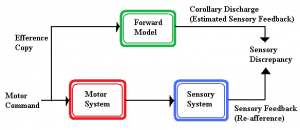![By Polygon data were generated by Database Center for Life Science(DBCLS)[2]. - Polygon data are from BodyParts3D[1], CC BY-SA 2.1 jp, https://commons.wikimedia.org/w/index.php?curid=32490636](https://ikblijffietsen.nl/wp-content/uploads/2018/06/Prefrontal_cortex_left_-_lateral_view-150x150.png)
![By 3D brain data is from Anatomography. (3D brain data is from Anatomography.) [CC BY-SA 2.1 jp (https://creativecommons.org/licenses/by-sa/2.1/jp/deed.en)], via Wikimedia Commons](https://ikblijffietsen.nl/wp-content/uploads/2018/05/Brodmann_area_4_lateral-150x150.jpg)
Motor preparation is a fascinating cognitive function, and multiple features are relevant for how a cyclist steers through a turn:
- Motor preparation is delayed movement
- Motor preparation is both overt and covert
- Motor preparation can be automated
These three properties are now discussed more extensively.
1. Motor preparation is delayed movement
In many situations, perception and movement are closely interwoven. This is very clear when we study staying upright, especially at low speed: our vestibular organ can detect small deviations from the equilibrium state (straight up) and may elicit a movement (steering impulse or weight displacement) that restores the equilibrium. Also in motor preparation, perception and movement are linked to each other, but here they are more separated in time. This is an important difference between staying upright and steering: when steering we first observe the future trajectory, prepare our movements on the basis of this, and finally execute them. Thus, for staying upright, perception and movement almost immediately follow up on each other, whereas for steering, perception clearly precedes movement. That is why we can view motor preparation as deferred movement or, in other words, as a movement plan. For staying upright there is no clear plan; before you are aware, an imbalance has already been corrected. The time difference between perception and movement is made possible by the fact that the neuronal circuits in the prefrontal cortex can remain active without sensory input; a motor program that has been set up does not require any new sensory input to keep that activity.

In the most extreme case it is possible to fully disconnect observation and movement. For example, a fellow passenger in a car can watch with the driver and help him navigate (“Here you have to go to the left!”). Being able to disconnect from perception and movement is a unique characteristic of the cognitive abilities of primates (humans, apes and monkeys). The reaction of lower animal species to a stimulus is usually immediate and stereotyped. Primates, on the other hand, can postpone their response, and that creates time to also base behavior on internal factors, usually referred to as weighing, planning, evaluating, etc.
2. Motor preparation is both overt and covert
“Overt” means “visible” and “covert” means “hidden”. The overt (visible) aspect of motor preparation during steering is the fact that the cyclist looks in the direction of his movement target (a location on his future trajectory). Looking in the direction of a movement target contributes to the accuracy of the observation, because it ensures that the movement target is in the central (most accurate) part of the field of view. The covert (hidden) aspect of motor preparation in steering is the fact that the cyclist can prepare his future movement without having to execute it immediately. Therefore, as an observer you can not tell a cyclist whether he has prepared for a future turn. You can only judge this at the moment he steers into the curve: if he steers in too late, he has insufficiently prepared himself.
3. Motor preparation can be automated
Strictly speaking, motor preparation is not a motor skill, because there is no movement during the preparation. This is an important difference with staying upright, which is a typical motor skill. The core of a motor skill is linking specific perceptions to specific movements. For staying upright, these perceptions pertain to our balance (as registered by our vestibular organ), the position of our joints, and the tension of our muscles (as registered by our proprioception). These links can be automated, and the cerebellum plays a crucial role in this.
An important question is whether also motor preparation can be automated. This question can not be answered immediately, and this is for the following reasons:
- Motor preparation is not a movement but a movement plan, and this is because of the time difference between the perception of a movement target and the movement.
- Motor preparation is a function of the prefrontal cortex, which is not directly connected to the muscles. Thus, the automation of motor preparation is not realised by linking perception and movements, but perception and a movement plan.
- The observations that must be linked to the movement plan are mainly visual and not vestibular nor proprioceptive, as would be the case for staying upright. Vestibular and proprioceptive input is only generated during the movement, whereas the relevant visual input is already available before the movement is initiated.

Our knowledge of the cerebellum strongly suggests that motor preparation can also be automated. In fact, there exists a network of neuronal connections that is needed to automate motor preparation in the same way as staying upright. We can explain this on the basis of the diagram on the right. The automation of staying upright starts from a signal (“Motor Command”) of the primary motor cortex that controls the muscles (“Motor System”) and a copy of this signal (“Efference Copy”) to the cerebellum (“Forward Model”). “). Automating motor preparation, on the other hand, starts from a signal (“Motor Command”) of the prefrontal cortex that controls the primary motor cortex (“Motor System”) and that also sends a copy of this signal (“Efference Copy”) to the cerebellum. The neuronal connections needed to send these efference copies to the cerebellum do not only exist for the primary motor cortex (automation of staying upright) but also for the prefrontal cortex (automation of motor preparation). The latter connections (from the prefrontal cortex to the cerebellum) only exist in primates.
The cerebellum controls the primary motor and the prefrontal cortex on the basis of the difference between perceived and predicted sensory feedback. For staying upright the relevant feedback comes from our vestibular organ and our proprioception, and it contains information about our balance (vestibular), the position of our joints and the tension of our muscles (proprioceptive). For motor preparation, the relevant feedback is visual, but it is not entirely clear what that information looks like. Here we reach the limits of our current scientific knowledge. From research with lower animal species we learned a lot about the neuronal connections between the primary motor cortex and the cerebellum. To learn more about the neuronal connections between the prefrontal cortex and the cerebellum we are dependent on research with primates, and that research is much slower.
In conclusion, it is very plausible that motor preparation can be automated, as is possible for staying upright. The crucial scientific knowledge that leads to this conclusion is the fact that the prefrontal cortex (needed for motor preparation) is connected to the cerebellum in the same way as the motor cortex (necessary for staying upright). This is positive news for cyclists who want to improve their cycling skills. This improvement can be realised for both skills: staying upright and motor preparation. By practicing motor preparation, the cyclist learns to steer more automatically, such that he can invest his attention more in detecting danger and avoiding it.